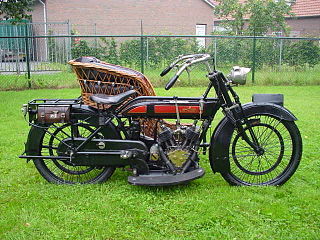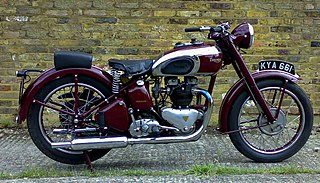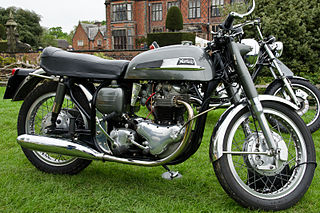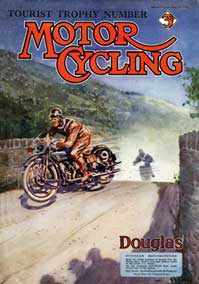
A flat-twin is a two-cylinder internal combustion engine with the cylinders on opposite sides of the crankshaft. It is a flat engine with two cylinders. Used in motorcycles for more than a century, flat-twins have also been used in automobiles, light aircraft, stationary powerplants, and household appliances.
Triumph Engineering Co Ltd was a British motorcycle manufacturing company, based originally in Coventry and then in Meriden. A new company, Triumph Motorcycles Ltd based in Hinckley, gained the name rights after the end of the company in the 1980s and is now one of the world's major motorcycle manufacturers.

Velocette is a line of motorcycles made by Veloce Ltd, in Hall Green, Birmingham, England. One of several motorcycle manufacturers in Birmingham, Velocette was a small, family-owned firm, selling almost as many hand-built motorcycles during its lifetime, as the mass-produced machines of the giant BSA and Norton concerns. Renowned for the quality of its products, the company was "always in the picture" in international motorcycle racing, from the mid-1920s through the 1950s, culminating in two World Championship titles and its legendary and still-unbeaten 24 hours at over 100 mph (161 km/h) record. Veloce, while small, was a great technical innovator and many of its patented designs are commonplace on motorcycles today, including the positive-stop foot shift and swinging arm rear suspension with hydraulic dampers.

The Cotton Motor Company, was a British motorcycle manufacturer of 11a Bristol Road, Gloucester, and was founded by Frank Willoughby Cotton in 1918. F.W. presided over the company until his retirement in 1953. The company was reconstituted as E. Cotton (Motorcycles) Ltd, and traded until 1980. The marque was later resurrected in the late 1990s by a business which manufactured replicas of earlier machines.

Francis & Barnett Limited was an English motorcycle manufacturer founded in 1919 by Gordon Inglesby Francis and Arthur Barnett and based in Lower Ford Street, Coventry, England. Early motor cycles were affectionately known as ' Franny B'. Motorcycles were produced for enthusiasts and was reasonably affordable for citizens for use as general transport. The majority of the lighter motorcycles used Villiers and later Two-stroke engine and later Associated Motor Cycles AMC engines. During the 1930s the 250cc Cruiser model 250 cc (15 cu in) was developed with a faired engine that protected those riding from any oil or dirt – one of the first of its kind to do so. AMC took over Francis & Barnett Limited in 1947 combining this with the James motorcycle models in 1957. The combined company remained in business until 1966.
Greeves Motorcycles was a British motorcycle manufacturer founded by Bert Greeves which produced a range of road machines, and later competition mounts for observed trials, scrambles and road racing. The original company produced motorcycles from 1952, funded by a contract with the Ministry of Pensions for their Invacar, a three-wheeler for disabled drivers.

The Panther Model 100 was a British motorcycle. It had a 598 cc, 6.5:1 compression ratio, 87 mm × 100 mm, OHV sloper engine in a frame where the engine replaces the front down-tube. Panthers were manufactured in Cleckheaton, Yorkshire from 1900 to 1967. Launched in 1932, the Model 100 continued through to 1963. While the engine and overall layout stayed essentially the same, the specifications steadily evolved over these thirty or so years.
Victoria was a bicycle manufacturer in Nürnberg, Germany that made motorcycles from about 1901 until 1966. It should not be confused with a lesser-known, unrelated Victoria Motorcycle Company in Glasgow, Scotland that made motorcycles between 1902 and 1928.

The Sunbeam S7 and S8 are British motorcycles designed by Erling Poppe with styling loosely based on the BMW R75 designs that were acquired as war reparations by BSA. Built in Redditch, the unusual engine layout was similar to that of a car. The engine was a longitudinally mounted inline vertical OHC 500 cc twin based on an experimental 1932 BSA design with coil ignition and wet sump lubrication which, through a dry clutch, drove a shaft drive to the rear wheel. The inline engine made this technologically feasible—horizontally-opposed ("flat") twin engines on BMW motorcycles had already used shaft drives following the system employed by Nimbus in 1918. The early S7 was expensive and over engineered, which is why it is now the most sought-after and commands a premium over the S7 De Luxe and the S8, which were produced with fewer features to reduce costs, while retaining many of the innovative parts of the early Sunbeam and updating some ideas.

The Speed Twin 5T is a motorcycle that was made by Triumph at their Coventry, and later Meriden factories. Edward Turner, Triumph’s Chief Designer and Managing Director, launched the Triumph Speed Twin at the 1937 National Motorcycle Show. It was a 500 cc OHV vertical twin in a lightweight frame and the first truly successful British parallel twin, setting the standard for many twins to follow. After World War II the Speed Twin was responsible for the survival of Triumph - and every major British marque offered a 500 cc twin designed on similar lines to the Speed Twin.

The Williamson Flat Twin was motorcycle made in Coventry, UK by William ('Billy') Williamson, who had been managing director of the Coventry-based Rex company. He teamed up with William Douglas (of Douglas Motorcycles to develop new prototype motorcycles under the name Williamson-Douglas and employed Billy's brother Harold as a test rider. Douglas had been developing a 964 cc water-cooled flat twin engine that could be used either for light cars or motorcycles. Billy Williamson fitted this engine into a frame with Douglas-Druid girder forks and a Douglas two-speed gearbox and a foot-operated clutch which was launched in 1912 at a cost of £82. In 1913 an air-cooled version was added to the range and in 1914 a kick starter was added. Production was halted by World War I and in 1919 the only engines available were JAP 980 cc air-cooled side valves, so Williamson redesigned the frame to fit. Unfortunately Billy Williamson suffered a fatal heart attack in 1920 after only twenty motorcycles had been produced.

The Douglas Dragonfly is a motorcycle designed and built by Douglas motorcycles in Bristol. The last motorcycle produced by the company, the 1955 Dragonfly was an all-new motorcycle built to use an improved version of an existing engine. Despite its riding comfort, which was "equal to a car's", it did not sell well, and only 1,457 Dragonfly motorcycles were produced before the company was taken over and production ended in 1957.Very few Douglas motorcycles survive today making it one of the rarest motorcycles for collectors.

The Dominator is a twin cylinder motorcycle developed by Norton to compete against the Triumph Speed Twin. The original Dominator was designed in 1947 and 1948 by Bert Hopwood, who had been on the Speed Twin design team at Triumph. Available for sale from mid 1949, this design set the pattern for Norton twins for the next 30 years.

The Royal Enfield Bullet was originally a British overhead valve single cylinder four-stroke motorcycle made by Royal Enfield in Redditch, Worcestershire, now produced by Royal Enfield (India) at Chennai, Tamil Nadu, a company originally founded by Madras Motors to build Royal Enfield motorcycles under licence in India. The Royal Enfield Bullet has the longest unchanged production run of any motorcycle having remained continuously in production since 1948. The Bullet marque is even older, and has passed 75 years of continuous production. The Royal Enfield and Bullet names derive from the British company having been a subcontractor to Royal Small Arms Factory in Enfield, London.

The Brough Superior Golden Dream was designed and built by George Brough in Nottingham, England, in 1938. With its distinctive gold finish, this was to be the ultimate Brough Superior but production was stopped by the outbreak of War in 1939.

The Matchless G12 is a British motorcycle made by Associated Motorcycles at the former Matchless works in Plumstead, London. Developed in 1958 specifically to capture the potentially lucrative US market, the last G12 was produced in 1966.

The AJS Model 16 was a British motorcycle made by Associated Motorcycles at the former Matchless works in Plumstead, London.

The BSA A7 was a 500cc motorcycle model range made by Birmingham Small Arms Company (BSA) at their factory in Armoury Road, Small Heath, Birmingham. The range was launched in 1946 using a 495 cc (30.2 cu in) long stroke engine. A improved 497 cc (30.3 cu in) version based on the BSA A10 engine was launched in 1950. The various A7 models continued in production with minor modifications until 1961/2 when they were superseded by the unit-construction A50 model.

Bradbury Motor Cycles was a British motorcycle manufacturer based in Oldham, England and established in 1902. Originally involved in the manufacture of machine tools, sewing machines and cycles, their first motorcycles were bicycles with clip-on Minerva engines. The Bradbury factory went on to develop and produce a range of single-cylinder motorcycle, V-twins and horizontally opposed twins. The 1912 Bradbury motorcycles were one of the earliest with variable gearing. Although the factory survived the First World War it closed in 1924.



























